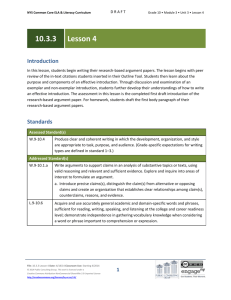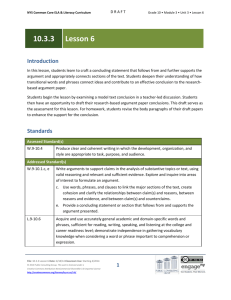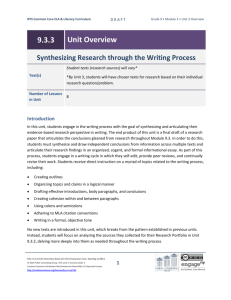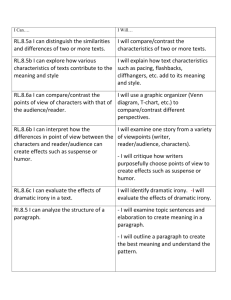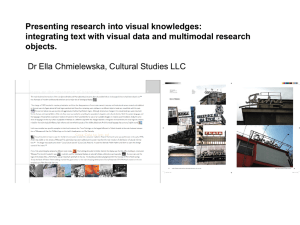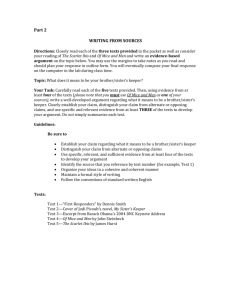108.8 KB - EngageNY
advertisement
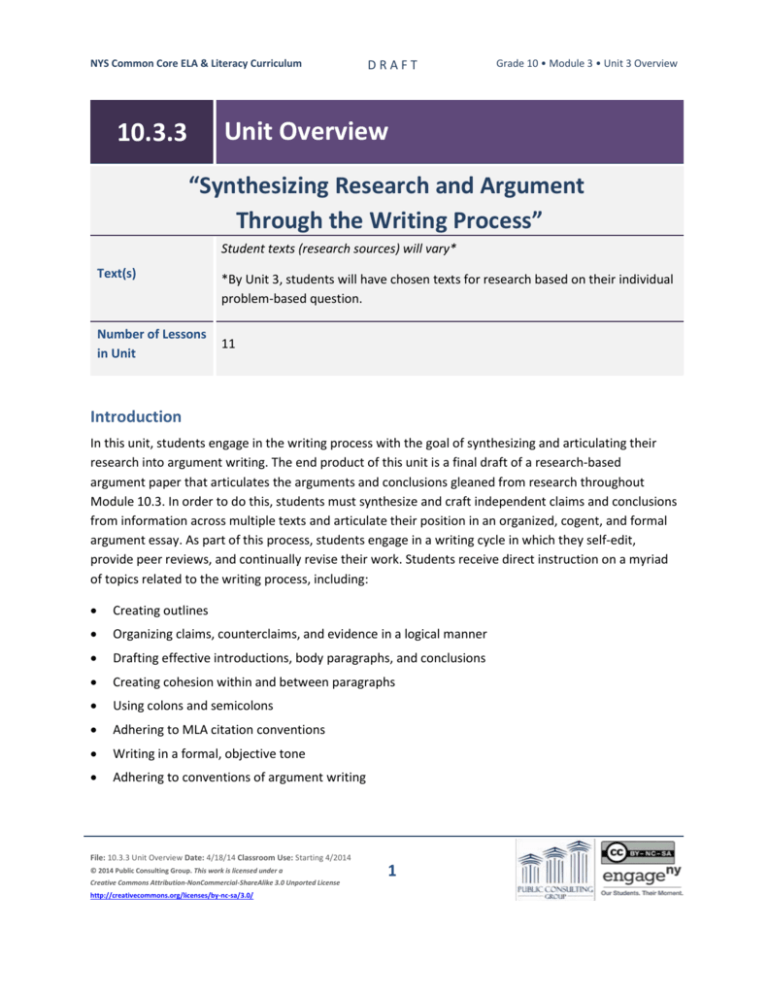
NYS Common Core ELA & Literacy Curriculum DRAFT Grade 10 • Module 3 • Unit 3 Overview Unit Overview 10.3.3 “Synthesizing Research and Argument Through the Writing Process” Student texts (research sources) will vary* Text(s) Number of Lessons in Unit *By Unit 3, students will have chosen texts for research based on their individual problem-based question. 11 Introduction In this unit, students engage in the writing process with the goal of synthesizing and articulating their research into argument writing. The end product of this unit is a final draft of a research-based argument paper that articulates the arguments and conclusions gleaned from research throughout Module 10.3. In order to do this, students must synthesize and craft independent claims and conclusions from information across multiple texts and articulate their position in an organized, cogent, and formal argument essay. As part of this process, students engage in a writing cycle in which they self-edit, provide peer reviews, and continually revise their work. Students receive direct instruction on a myriad of topics related to the writing process, including: Creating outlines Organizing claims, counterclaims, and evidence in a logical manner Drafting effective introductions, body paragraphs, and conclusions Creating cohesion within and between paragraphs Using colons and semicolons Adhering to MLA citation conventions Writing in a formal, objective tone Adhering to conventions of argument writing File: 10.3.3 Unit Overview Date: 4/18/14 Classroom Use: Starting 4/2014 © 2014 Public Consulting Group. This work is licensed under a Creative Commons Attribution-NonCommercial-ShareAlike 3.0 Unported License http://creativecommons.org/licenses/by-nc-sa/3.0/ 1 NYS Common Core ELA & Literacy Curriculum DRAFT Grade 10 • Module 3 • Unit 3 Overview No new texts are introduced in this unit, which breaks from the pattern established in previous units. Instead, students focus on analyzing the sources they collected for their Research Portfolios in 10.3.2, delving more deeply into them as needed throughout the writing process. The formal assessment for this unit is the final draft of the research-based argument paper. In the final lesson of this unit—after students have had the opportunity to outline, draft, revise, and edit their paper—students submit their final papers for assessment against the 10.3.3 Rubric and Checklist, which students use throughout the unit to facilitate their writing process. Literacy Skills and Habits Collect and organize evidence from research to support analysis in writing. Analyze, synthesize, and organize evidence-based claims. Write effective introduction, body, and conclusion paragraphs for a research-based argument paper. Use proper MLA citation methods in writing. Edit for a variety of purposes, including using semi-colons, colons, and correct spelling. Use formal style and objective tone in writing. Adhere to conventions of argument writing (e.g., addressing all sides of an issue, avoiding emotional appeals). Write coherently and cohesively. Standards for This Unit CCS Standards: Writing W.910.1.a-e Write arguments to support claims in an analysis of substantive topics or texts, using valid reasoning and relevant and sufficient evidence. Explore and inquire into areas of interest to formulate an argument. a. Introduce precise claim(s), distinguish the claim(s) from alternate or opposing claims, and create an organization that establishes clear relationships among claim(s), counterclaims, reasons, and evidence. b. Develop claim(s) and counterclaims fairly, supplying evidence for each while pointing out the strengths and limitations of both in a manner that anticipates the audience’s knowledge level and concerns. File: 10.3.3 Unit Overview Date: 4/18/14 Classroom Use: Starting 4/2014 © 2014 Public Consulting Group. This work is licensed under a Creative Commons Attribution-NonCommercial-ShareAlike 3.0 Unported License http://creativecommons.org/licenses/by-nc-sa/3.0/ 2 NYS Common Core ELA & Literacy Curriculum DRAFT Grade 10 • Module 3 • Unit 3 Overview c. Use words, phrases, and clauses to link the major sections of the text, create cohesion, and clarify the relationships between claim(s) and reasons, between reasons and evidence, and between claim(s) and counterclaims. d. Establish and maintain a formal style and objective tone while attending to the norms and conventions of the discipline in which they are writing. e. Provide a concluding statement or section that follows from and supports the argument presented. W.9-10.4 Produce clear and coherent writing in which the development, organization, and style are appropriate to task, purpose, and audience. W.9-10.5 Develop and strengthen writing as needed by planning, revising, editing, rewriting, or trying a new approach, focusing on addressing what is most significant for a specific purpose and audience. W.9-10.7 Conduct short as well as more sustained research projects to answer a question (including a self-generated question) or solve a problem; narrow or broaden the inquiry when appropriate; synthesize multiple sources on the subject, demonstrating understanding of the subject under investigation. W.9-10.8 Gather relevant information from multiple authoritative print and digital sources, using advanced searches effectively; assess the usefulness of each source in answering the research question; integrate information into the text selectively to maintain the flow of ideas, avoiding plagiarism and following a standard format for citation. W.9-10.9 Draw evidence from literary or informational texts to support analysis, reflection, and research. File: 10.3.3 Unit Overview Date: 4/18/14 Classroom Use: Starting 4/2014 © 2014 Public Consulting Group. This work is licensed under a Creative Commons Attribution-NonCommercial-ShareAlike 3.0 Unported License http://creativecommons.org/licenses/by-nc-sa/3.0/ 3 NYS Common Core ELA & Literacy Curriculum DRAFT Grade 10 • Module 3 • Unit 3 Overview CCS Standards: Speaking & Listening SL.9-10.1 Initiate and participate effectively in a range of collaborative discussions (one-on-one, in groups, and teacher-led) with diverse partners on grades 9–10 topics, texts, and issues, building on others’ ideas and expressing their own clearly and persuasively. CCS Standards: Language L.9-10.1.a Demonstrate command of the conventions of standard English grammar and usage when writing or speaking. a. Use parallel structure. L.9-10.2.a-c Demonstrate command of the conventions of standard English capitalization, punctuation, and spelling when writing. a. Use a semicolon (and perhaps a conjunctive adverb) to link two or more closely related independent clauses. b. Use a colon to introduce a list or quotation. c. Spell correctly. L.9-10.3.a Apply knowledge of language to understand how language functions in different contexts, to make effective choices for meaning or style, and to comprehend more fully when reading or listening. a. Write and edit work so that it conforms to the guidelines in a style manual (e.g., MLA Handbook, Turabian’s A Manual for Writers) appropriate for the discipline and writing type. L.9-10.6 Acquire and use accurately general academic and domain-specific words and phrases, sufficient for reading, writing, speaking, and listening at the college and career readiness level; demonstrate independence in gathering vocabulary knowledge when considering a word or phrase important to comprehension or expression. Note: Bold text indicates targeted standards that will be assessed in the unit. File: 10.3.3 Unit Overview Date: 4/18/14 Classroom Use: Starting 4/2014 © 2014 Public Consulting Group. This work is licensed under a Creative Commons Attribution-NonCommercial-ShareAlike 3.0 Unported License http://creativecommons.org/licenses/by-nc-sa/3.0/ 4 NYS Common Core ELA & Literacy Curriculum DRAFT Grade 10 • Module 3 • Unit 3 Overview Unit Assessments Ongoing Assessment Standards Assessed W.9-10.4, W.9-10.5, W.9-10.9 Description of Assessment Varies by lesson but may include drafted portions of the essay with a focus on the specific goal of individual lessons (e.g., introduction development, cohesion within and between paragraphs, proper citation methods, and incorporation of peer and teacher feedback). End-of-Unit Assessment Standards Assessed W.9-10.1.a-e, L.9-10.1, L.9-10.2, L.9-10.3.a, L.9-10.6 Description of Assessment Students are assessed on the alignment of the final draft to the criteria of the 10.3.3 Rubric and Checklist. The final draft should present a precise claim that is supported by relevant and sufficient evidence and valid reasoning. The draft should be wellorganized, distinguishing claims from alternate and opposing claims and using language that clearly links the major sections of the text and clarifies relationships among the claims, counterclaims, evidence, and reasoning. Finally, the draft should show control of the conventions of written language and maintain a formal style and objective tone. Unit-at-a-Glance Calendar Lesson 1 Text Learning Outcomes/Goals Research Portfolio Texts Students are introduced to the process of drafting research-based argument papers. Students learn how to develop their researchbased argument papers from the Evidence-Based Perspectives they completed in the previous unit (10.3.2 Lesson 13). Students organize their supporting claims and evidence for each claim in a well-reasoned manner, while analyzing the evidence that best File: 10.3.3 Unit Overview Date: 4/18/14 Classroom Use: Starting 4/2014 © 2014 Public Consulting Group. This work is licensed under a Creative Commons Attribution-NonCommercial-ShareAlike 3.0 Unported License http://creativecommons.org/licenses/by-nc-sa/3.0/ 5 NYS Common Core ELA & Literacy Curriculum DRAFT Grade 10 • Module 3 • Unit 3 Overview supports each claim to complete the Outline Tool. 2 Research Portfolio Texts Students continue to plan for their argument-based research papers by completing the Outline Tool introduced in the previous lesson. Students develop a counterclaim in opposition to their central claim developed in the previous lesson. Students address the strengths and limitations of their central claim by developing supporting claims for their counterclaim. 3 Research Portfolio Texts Students learn how to effectively integrate citation information into their writing to maintain the flow of ideas, avoid plagiarism, and follow a standard format for citation. Students learn MLA conventions for in-text citation as well as for a Works Cited page. Students draft a Works Cited page. 4 Research Portfolio Texts Students begin writing their research-based argument papers. The lesson begins with peer review of the in-text citations students inserted in their Outline Tools. Students then learn about the purpose and components of an effective introduction. Through discussion and examination of an exemplar and non-exemplar introduction, students further develop their understandings of how to write an effective introduction. 5 Research Portfolio Texts Students focus on building cohesion and clarity as they continue to draft their research-based argument papers. Students work to improve the effectiveness of their writing by focusing on the use of transitional words and phrases and building strong relationships between evidence, claims, and counterclaims within their papers. 6 Research Portfolio Texts Students learn to craft a concluding statement that follows from and further supports the argument and appropriately connects sections of the text. Students deepen their understandings of how transitional words and phrases connect ideas and contribute and shape reasoning by developing the closing statements of their research-based argument papers. 7 Research Portfolio Texts Students learn how to identify and use formal style and objective tone when writing their research-based argument papers. After receiving instruction on formal style and objective tone, students use the first drafts of their papers to participate in peer review File: 10.3.3 Unit Overview Date: 4/18/14 Classroom Use: Starting 4/2014 © 2014 Public Consulting Group. This work is licensed under a Creative Commons Attribution-NonCommercial-ShareAlike 3.0 Unported License http://creativecommons.org/licenses/by-nc-sa/3.0/ 6 NYS Common Core ELA & Literacy Curriculum DRAFT Grade 10 • Module 3 • Unit 3 Overview and teacher conferences. 8 Research Portfolio Texts Students learn how to revise for formal tone and conventions in argument writing. Additionally, students continue to analyze and revise their claims and counterclaims fairly. After receiving instruction on the norms and conventions of research-based argument writing, students use their first drafts to participate in peer review and teacher conferences. 9 Research Portfolio Texts Students continue to edit and revise their papers. They are also introduced to semicolons as a way to join independent clauses and colons as a means of introducing quotes or lists. Students continue the peer review process for capitalization, punctuation, and spelling. 10 Research Portfolio Texts Students participate in a peer review activity during which they offer constructive feedback to their classmates about their entire research-based argument papers. Students review their peers’ papers for elements of the W.9-10.1 standard and supporting standards (W.9-10.1 a-e) that have been introduced in this unit. Additionally, students peer review for English grammar and usage and writing conventions. 11 Research Portfolio Texts In this last lesson of the unit, students work in class to finalize their research-based argument papers (End-of-Unit Assessments), editing, polishing, and rewriting as necessary. Students are evaluated on the final draft’s alignment to the criteria of the 10.3.3 Rubric and Checklist. Preparation, Materials, and Resources Preparation Review the 10.3.3 Rubric and Checklist. Review all unit standards and post in classroom. Consider creating a word wall of the vocabulary provided in all lessons. File: 10.3.3 Unit Overview Date: 4/18/14 Classroom Use: Starting 4/2014 © 2014 Public Consulting Group. This work is licensed under a Creative Commons Attribution-NonCommercial-ShareAlike 3.0 Unported License http://creativecommons.org/licenses/by-nc-sa/3.0/ 7 NYS Common Core ELA & Literacy Curriculum DRAFT Grade 10 • Module 3 • Unit 3 Overview Materials/Resources Chart paper Writing utensils including pencils, pens, markers, and highlighters Methods for collecting student work: student notebooks, folders, etc. Access to technology (if possible): interactive white board, document camera, LCD projector, computers for individual students (for word processing) Copies of the 10.3.3 Rubric and Checklist File: 10.3.3 Unit Overview Date: 4/18/14 Classroom Use: Starting 4/2014 © 2014 Public Consulting Group. This work is licensed under a Creative Commons Attribution-NonCommercial-ShareAlike 3.0 Unported License http://creativecommons.org/licenses/by-nc-sa/3.0/ 8
